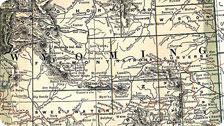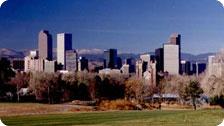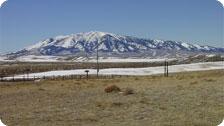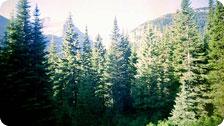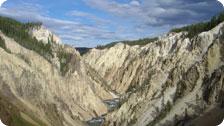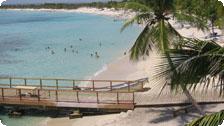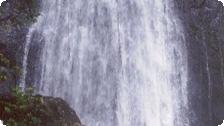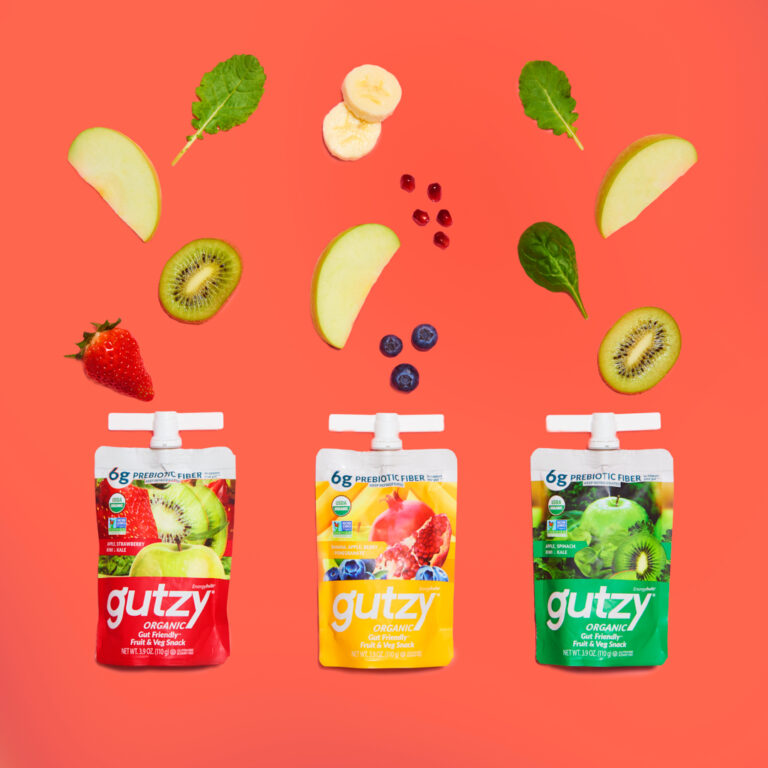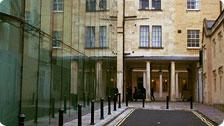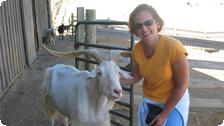Wellness: USA: Out West
by Christine Ann Guth
Those of you who know me are aware that if something disastrous yet strange is going to happen, it is going to happen to me. I don’t just back into any car—I back into a CNN van covering the Presidential primaries and carrying a $100,000 camera. I don’t have just a regular thief breaking into my apartment building, I have a cross-dressing thief who is stealing my neighbor’s bras and lipstick—but only the shade of Spiced Cider. My old car doesn’t just die anywhere—it gives up the ghost right inside the Wellesley town dump. And the list goes on. This is my life, and that’s fine; most of the time I sit back and find it all highly entertaining. Now why did I think my trip out west would be any different?
I have been dying to go west. I’ve heard many stories about how fabulous it is, how different from the east coast. But except for a brief visit to my grandfather in Tucson when I was ten, the farthest west I had been was Pittsburgh. It is a really busy time for the research lab I’ve been working in after college and hard to get away, but so isn’t every time? Two weeks ago, I just had this overwhelming desire to flee, so I did. Alone.
I log on to Priceline.com and place my bid for tickets to Denver. My bid is rejected twice on Thursday, but I decide to put it in one last time, in the wee hours of Friday morning. Fifteen minutes later, bingo: I have my plane tickets, and after another ten minutes, I have rented an economy car.
I’m leaving the next day, Saturday. I don’t tell anyone I’m going, except for my supervising professor (at four p.m. Friday, as I’m headed out the door). I think about calling her from a mountaintop on my cell phone and telling her I won’t be in that week, but I decide to go for the personal touch instead. I rush to AAA and tell the guy that I’m going out west to drive around and need some maps. He seems to get into the idea that I want to see the general everything, and starts throwing me maps and guidebooks of Arizona, Utah, New Mexico, Idaho, etc., on top of the Colorado, Wyoming, and Montana maps I ask for—just in case I get the urge, he says. I like his style—who knows where I’ll wind up? That is the point.
I hop on the plane and land in Denver late Saturday night. I head for the rental car place to pick up my economy (ten-year-old Ford Taurus or equivalent) car. The woman tells me I have a little white Kia Sephia parked in space A9. She forgets to include on the bill the twenty-dollar-per-day surcharge because I am under twenty-five. I go out to A9, but there is no car there. I find the parking lot attendant, who looks at my rental form and comes back ten minutes later with a huge white SUV. I insist that this is not my car—I am paying $215 for the week for a piece of junk, not this nice thing. He drives away, and comes back with a huge dark green SUV. It is a pleasing offering, but I know it is not mine. The rental woman comes out, looks at my form and says that I should smile, be happy and drive away—this is my car. Apparently, she has made a mistake with the abbreviations and rented me a Kia Sportage instead of a Kia Sephia. I head to a thirty-dollar-a-night motel in Aurora, outside Denver, and in the parking lot on the way to my room walk past many drug deals and people hanging over junk cars. I have no plan of where to go the next day. I figure I have my pile of maps and a Scenic Highways and Byways book, so I’ll just figure out each night where I am headed the next day. I decide to go north into Wyoming, headed toward the Tetons and Yellowstone, on my way to Glacier National Park in Montana. I get up at five a.m. and see my first real mountains on the drive out of Colorado. They are beautiful; I had no idea what I have been missing.
My western driving technique is unique and apparently not appreciated by some of the other drivers on the road. I love to drive, so the open roads out west are paradise. I cruise at ninety singing Bob Dylan, and yes, John Denver songs off key, passing cars. Then I see something so beautiful that I must have a picture, screech on the breaks, and hop out barefoot to take the photo; every car I just passed passes me back. I dive back into the car and tear off, repeating the whole process over and over. I stop in Laramie, Wyoming for a drink at a Quickmart and head for the scenic drive in my book, the Snowy Range Road through Medicine Bow National Park. It is beautiful, and I pull over at the Libby Flats Observation Point. I leave my window halfway rolled down.
There are about five other cars there: families, old people, etc. I run to the lookout, have some guy take my picture, and run back to my car. I continue the scenic drive until I notice I am running low on gas, and stop at the “town” of Earl, Wyoming (population two, elevation 8,000 feet). I reach for my wallet on the passenger’s seat—and it’s not there. I’m not panicked yet—I just methodically search the car, assuming it fell under a seat, or that I put it in the glove compartment instead…but it’s not anywhere. I search through every nook and cranny, every bag, but the wallet is gone. I have everything in there—$300 in cash, all my credit cards, phone cards, blank checks, driver’s license, passport, birth certificate…I don’t have a dime, am almost out of gas, I’m alone, I don’t know anyone out west, and I haven’t told anyone that I have left Massachusetts. Also, I know that I cannot pick up my plane ticket home without photo ID.
I take a breath and go inside the little gas station shack. I explain to the old, bearded guy there (he must be Earl, the town founder) that my wallet has been stolen and that I need to use his phone to call the police. He grumbles, “Well, I reckon you can make one call, but real quick, ‘cause I’ve got business, you know.” I think, for goodness sake, it is nine in the morning and you are in a town of a population of two—who on earth are you going to call about business? I notice then that there are two houses in the town of Earl—must be for when he and his wife are feuding. He tells me the sheriff’s phone number from memory—that in itself is frightening—and I dial. The police claim that because the last time I know I had the wallet is in Laramie, I need to call the sheriff there. Well, old Earl won’t let me use his phone again. So I run to my car and whip out the cell phone my mom made me buy just a week before. I dial, and hum spiritual hymns for a minute as the phone searches for service. It finally starts to dial, and all of a sudden flashes low battery; then it dies. Now, not being a cell phone enthusiast, and, of course, just having bought the thing the week before, I don’t have a car re-charger. So I go back in to the gas shack to deal with Earl. Tears work with this man. I call the police in Laramie, and am told that because I believe the wallet was stolen at the lookout in Medicine Bow, I need to call the first sheriff’s office again. I don’t even look at Earl as I hang up and dial the number—he’ll just have to deal. Nancy, a kind officer, answers this time and tells me to drive to their office in Rawlins; we will take care of everything there. So I run to my car and remember that I am almost out of gas, and that Rawlins is half an hour away. Now, we know that there is no way Earl is going to lend me a few dollars of gas, so I just cross my fingers and drive off.
I arrive at the sheriff’s office in Rawlins at the same time as this older woman with dyed black hair who has come to bail out her honey. The officer thinks we’re together, and tells us Jim’s fight wasn’t too bad this time, that he is still a little liquored up, but we can visit him upstairs. I’m absolutely horrified, and I guess it shows, because the officer then asks if we’re together. I quickly explain about the wallet, and am escorted to officer Nancy. She is wonderful, helps me write out the police report, and I start canceling credit cards.
Now I’ve got this problem about money. I have none. Because it is the Sunday before the fourth of July, every credit card company tells me that I cannot get a new card before Wednesday, July fifth, and that I need a physical address to send it to. I have no idea where I’ll be, and have no intention of staying in my out-of-gas car in Rawlins until then. I remember that my parents are at their cabin in West Virginia, without a phone. I go through the list of relatives I can call, and no one is home. So I call my best friend Sara.
She drives the hour over to my apartment back in Massachusetts and digs through all my credit card and bank information with the help of the Mary Poppins-esque elderly woman across the hall, Janet, who is taking care of my cat. Through the phone, I can hear my cat yowling and trying to rip apart Sara’s son John, and hear Janet cooing, “Oooh, poor Chrissy! She needs to sit down and have a cup of tea.” It is all very surreal.
I call Western Union and find out that there is an open office in the supermarket in Rawlins, but that if Sara wires me money with a credit card, I need to have photo ID in order to pick it up—which I don’t have. If she wires cash, we just need to agree on a password—no ID required. But she can only come up with thirty dollars cash, her bank isn’t open on Sundays, and she has no ATM card. I call Western Union again, desperate to find some way that I can get money from the last credit card I have not yet canceled. I tell the Western Union woman that I am in a police station in Rawlins and desperately need to wire myself money. She pauses, says that she doesn’t mean to pry, but do I by any chance need this money for bail? I’m dying, but decide to follow this avenue and see where it leads—I hesitantly reply yes. She says, “OK, we can work with this—let me talk to my supervisor.” She’s gone for about ten minutes, comes back, and says that because it is for bail, her supervisor has approved the transaction. I need to have a uniformed officer go down to the Western Union office and pick up my “bail” money. Me, needing bail!
I get money, and am instructed by officer Nancy that I am to talk to no one under the age of sixty-five and that I am only to spend the night at places that say “family campground.” I thank her profusely and take off. I backtrack and retrace my route through the park, hoping that the bad guy has just taken the cash and thrown the wallet somewhere, but no luck. I decide to head for the Tetons and Yellowstone, and think I’ll make it there by dark. I have no conceptual clue how very big these states are; I am used to New England, where you drive across a state in a few hours, not in a day. I drive until about ten at night and am still well over a hundred miles from the park. Dead tired, I finally pull off to the side of the desolate road to try to sleep in the back of my car. I think every sound is a grizzly bear or an axe murderer.
A friend joked with me later that we should have called the National Rifle Association and told them a member is in distress out in Wyoming without her gun. I could just picture a cowboy pulling up in his big Chevy pickup, lifting a 30-0-6 off of his gun rack, and throwing it to me with a “Howdy, ma’am.” That, or I would have had the phone number of every cult leader or future Ted Kaczynski. Instead, although I hate to do so, I opt to call out Mother Wellesley, my college alumnae association, which puts me in touch with Frannie of the Arizona Wellesley Club. Frannie is about eighty years old and is just absolutely beside herself that a young alum is alone, in the middle of nowhere, and in such a predicament. She pulls out her alumnae directory and sets about calling all the other eighty-year-old Wellesley alums in Wyoming, Montana, and Colorado, alerting them of the situation. She gives me all their phone numbers in case I have any more tragedies. I now have a network of grandmas on my side and at the ready. Frannie gets in touch with Suzi of the Denver Wellesley Club, and I have a credit card and photocopies of my passport and old school IDs Fed Exed to her. All right, sisterhood!
I start again at five a.m., and not an hour into my drive, this huge rock is kicked off the back of a tractor trailer, and cracks my windshield. I think, well, it’s alright because I made sure before I left home that I have auto insurance through my credit card. Well, I stop at the next gas station, and call the credit card company to make the claim. The woman asks me what kind of car. When I tell her it is a Kia Sportage, she says that that is an SUV, which they do not cover. OK, I have no insurance or money and need a $300 windshield. But there is nothing I can do about this now, so I continue on. I am blown away by the amazing Tetons and Yellowstone, stop to do a few trail runs, at Old Faithful, at all the beautiful hot springs, the waterfalls, and at all the tourist sites. I do not get five feet from a bison to take a picture like some of the other silly tourists. I start north through Montana on the most gorgeous road, US 89. I am getting tired around nine p.m., so I stop at a national forest where there is supposed to be camping. I follow the road for ten miles through the pre-dusk mist and don’t see a soul. I turn left up this steep rocky road and follow it to the campsite. Not a single person is there on the third of July, the place is run down, and this eerie mist hangs over everything. Now, I have not seen The Blair Witch Project, but I have a good enough idea of what it is to have the horror of that movie replaying through my mind as I look around. It is free to camp here and quite beautiful in the forest, but I just can’t do it—I’m too scared. I leave without getting out of my car. I prop my eyelids open and drive an hour northwest to Route 15, spending the night at a safe family campground in Helena, Montana that has bingo and nightly sing-a-longs.
I leave at five a.m. and head north for Glacier, the park I have dreamed for years of visiting. I notice many guys in old pickups and cowboy hats. It is the Fourth of July, and as I take a shortcut through the town of “DePaul,” I am detoured by a sheriff who exactly resembles Boss Hogg of the Dukes of Hazzard—they are having a town parade. I do my best to make it through the maze of blocked streets and detours, but am ultimately cut off by a thirty-year-old Cadillac carrying the smiling mayor and his wife as they lead the parade. I figure if you can’t beat ‘em, join ‘em. I get out of my car and stand with all the townspeople (and guys in cowboy hats!) watching the other town dignitaries and Miss Teen Montana Big Sky ride by. I watch as these poor horses with braided tails and white stars painted on their behinds, carrying women in stars and stripes leotards, are forced to prance and dance down the street to the tune of the brass band marching behind them.
I finally arrive at Glacier. It is very cold and windy, but only just inside the park is there a huge, dark cloud hanging low and rain falling. I drive Going-to-the-Sun road, called an engineering masterpiece because of how it winds alongside and up these huge mountains; it’s also called the most beautiful road in the country. It is magical—as beautiful as I have imagined. It begins to snow as I get to higher elevations (snow on the Fourth of July!). I am very tired, and decide to pull over at the visitor’s center at the top of Logan Pass for a nap. The sound of tapping on my window awakens me three hours later—a ranger has noticed my snow-covered car in the parking lot. He says that they have closed down the road: I am in the exact middle of the twelve-mile stretch that is closed, and must get out of there. I drive off, trying to see through the driving snow and the windshield crack that has exponentially expanded. Now, I have only ever driven an automatic transmission vehicle on two very short occasions before this trip (I can go on for hours about the virtues of the stick shift), so I am an absolute mess trying to stay on this snowy road with no shoulder and these huge several-thousand-foot drop-offs, unable to see. But I make it. I decide to stay at the Sprague Creek campground in Glacier for the night. It is absolutely freezing, and I haven’t brought a winter sleeping bag or many winter clothes. I pitch my tent, buy a bunch of local newspapers to line my tent with, and pile all my clothes inside as insulation. I head off to the nearby town of Whitefish to watch the Fourth of July fireworks, which are beautiful. As I freeze and try to drift off to sleep, I start to read the newspapers I have lined my tent with, and learn about a bear attack last week in the exact area I wanted to hike, near Many Glacier. The bear kept coming back to chew on the poor guy every few minutes—broke some ribs, ripped his arm open, etc. The park service is currently looking for the bear, but they believe it is the same one that has been seen around several campgrounds. I remember the story a gas station attendant told me earlier, that a bear recently broke the window of a car to get at the sealed can of Coke inside. It recognized the red patterned can. Yes, I’ll be having a good night’s sleep.
I get up at five a.m. and drive Going-to-the-Sun road again. It truly is even more breathtaking in the morning. I am going fifty in a forty mph zone, but no one else is on the road. All of a sudden, I see red and blue flashing lights. I pull over, and am actually trying not to laugh—what else can I do? I have no identification, very little money, and am driving an illegal vehicle because of the shattered windshield. Luckily, I am pulled over by two young, male park rangers; I receive a warning and am taken to breakfast.
I head south through Montana, and into Idaho. At one point, I stop at a gas station and these two creepy, older guys in an ancient, beat up Chevy piled with crap ask me for directions. I insist that I am not from around this area. One follows me inside the station as I go to pay, and quickly throws down his merchandise as I leave, running after me. I jump in my car and take off, watching their dust-cloud in the rearview mirror as they tear out of the station after me. I am headed for the Salmon River scenic drive. The road is just treacherous with twists, turns, and drop-offs, but I approach eighty until I finally lose them, half an hour later. I couldn’t stop to take pictures of this beautiful area, so I’m doubly mad at them. I take the scenic drive through the beautiful Sawtooth Range, and continue south. I spend the night in the parking lot of a truck stop in Southern Idaho. I had no idea until after I got home that truck stops are a big area for prostitutes. A friend half jokingly told me I was lucky some Idaho truck stop Madam didn’t think I was trying to move in on her turf and beat me up! I had no idea.
The farther south I am, the more beautiful and unusual the scenery becomes. I have never seen anything like these buttes, canyons, and rock formations. I had no idea mountains come in pink and purple. So I am headed for this scenic drive in southern Utah through Capitol Reef National Park. You head east on 70, and a sign reads no services for 112 miles. Well, in the middle of the 112 miles, you turn right and find this old dirt road that leads for fifty-six miles through the park. There is absolutely no sign of life anywhere; it really looks like the pictures of Mars. Now, the book I bought, the Scenic Highways and Byways one, is commonly distributed. I figured that Grandmas and Grandpas buy this book, pile in the Winnebago, and take off on these roads—they must be safe. The truth is, the road leads through a gorgeous desert area and is terribly treacherous. Rarely is there a sign at any branch in the road; it is incredibly easy to get lost. A huge dust-cloud trails my car as I maneuver through the canyons and across the desert. I mostly choose the direction in which the road is widest. Once, the choice is obvious—the left fork is decorated with a fifteen mph speed sign pierced with eight bullet holes. I turn right. The roadbed is sunken about two feet below the floor of the desert, which is a sandy ash and not solid enough to stand on without sinking. Now, I should have realized that I am driving through dried-out mudflats, and that the number of tire-tracks will indicate the number of vehicles that have passed this way since the last rain. Since mine are the only set, and since this is some desert in Utah, the last person could have been through a month ago.
About halfway through the fifty-six miles, I come upon a fork with a sign that states that Route 24, to which I am headed, is equidistant, left or right. I can go to Upper or Lower Cathedral Valley. It is a conundrum. I finally decide to stick to the high ground and go right to Upper Cathedral. The road becomes even worse as much of it passes through dry streambeds and then down fity-degree, winding slopes of silt piles. The road flattens and I speed up to about twenty-five mph. All of a sudden—boom!—there is a huge noise, the engine cuts off, my car is now significantly sloping downward in the front, and I am engulfed in a huge dust-cloud. The windows are wide open, so I am covered in dust and choking. After about a minute, I can see again, and open the door to find out what the heck has happened. I’m in a sinkhole. This huge sinkhole has opened up, and I am standing in a foot and a half of this dry, powdery silt. The back tires are up and still barely on solid ground. I look to my right and see this carcass of some dead, dried out animal, and think a Chrissy carcass will soon be joining it. I also think of all the old people in their Winnebagos dying in sinkholes out here in the middle of nowhere. I think of my dead cell phone in the glove compartment—AAA can’t save me now. I turn on the radio and press Seek but the only station I can get is a religious one. I wonder, do religious people buy extra powerful transmitting antennas just so that if someone does happen to be stuck in a sinkhole at the bottom of some canyon in a desert in Utah, one can think, well, at least Jesus can reach me here? I turn off the radio and set to the problem at hand. After about fifteen minutes of maneuvering, I am able to get the entire car back on solid ground. I am so lucky to be in this huge SUV rather than the economy Ford Taurus or equivalent; there is no way I would have made it out. The road is too narrow to turn around, and the silt of the desert floor too unstable to drive off road. I back up for a little under a mile before I reach a part wide enough to turn. The transmission is now making this horrible grinding, whining sound. I head back to the fork, and take the other direction, headed for Lower Cathedral. The road is pretty bad, and I land in two more sinkholes, but these are much smaller and I can pass through fairly easily.
I finally make it to Route 24, a nicely paved road, after passing many more beautiful formations, and even a pink lake. I head for another scenic drive, the Bicentennial Highway, past Lake Powell. I then head east, making tracks for Colorado. Glancing at the highway sign, I see that of course I am now driving on Route 666. I spend the night in the parking lot of another truck stop, and get an early start headed for the San Juan Skyway. I stop at a mini mall to call good old Suzi, the Wellesley alum in Denver, to make sure the Fed Ex package of ID and credit cards has arrived. As I head back out to my car, I see the passenger’s side door in the daylight for the first time in a long time. I notice three evenly-spaced, deep scratches—claw marks?!—in the door just underneath the handle. I don’t know what put them there, have absolutely no desire to speculate, and that is that. But now I have a shattered windshield, three scratches in the car, and a grinding transmission. Not to mention the inch of sinkhole dust both inside and outside the car. I fall in love with Colorado as I drive the San Juan Skyway, stopping in Durango and Silverton, where I go four-wheeling for a few hours through the Monarch Pass up by the gold mines. It is up by the ghost town of Animas Forks that I try to open the back hatch of the car for the first time since the sinkhole. You have to release a lever to swing out the spare tire before you can open the hatch. I guess the sinkhole bit me again, because the back will no longer open and I have to crawl over the seat to get my stuff. I see my auto rental bill growing.
It is getting into the afternoon on Friday, and my plane leaves at seven a.m. Saturday morning. I need to hurry up and get to Denver to try to get this car fixed up as best I can before I return it. I see that I am almost out of gas near Vail, Colorado, and stop. I pump a full tank before I realize that gas is three dollars per gallon. I almost choke, because I have exactly three dollars left after I have paid. I am so flustered by the price and my lack of money that I drive off with the gas cap on the roof, never to be seen again.
So now I’ve got this car with a shattered windshield, no gas cap, grinding, whining transmission, three huge, deep scratches down the passenger side, a back hatch that won’t open, and it is covered both inside and out in an inch of sinkhole dust. I have no insurance and three dollars. I consider hocking my worthless cell phone at one of the ten pawnshops in each town—and before I always thought pawnshops were a myth! I also consider stopping at one of the mini casinos next to every gas station and turning my three dollars into three hundred dollars, but since the only card games I play are Go Fish and UNO, I decided to hold onto my few dollars. I arrive in Denver and stop at an auto supply store. This huge, tattooed man asks if I need help, and I explain to him the situation. I need to get him on my side, because I have no money to pay for this stuff. I tell him that the auto rental company made this huge mistake giving me this SUV, because of course I’m going to do some serious off-roading with it. Now I’ve practically killed the car and have to get it fixed up before I return it tomorrow. He is very impressed and understands. Auto supply stores don’t sell Kia paint because it is a new, Korean car company. The car is this funky dark greenish color—of course, not black or some easy to match color. He finds a gas cap that fits and gives it to me. Then he comes out into the parking lot and starts buffing my car, trying to get the scratches out. No luck. He points me to a Kia dealership down the road, and I take off. I arrive at 6:30 p.m., rush in, and explain the situation to the auto sales guy. He says that their Parts and Services department deals with paint, and they closed half an hour ago. I see a man in overalls sitting outside a door that reads “Parts and Services,” and I ask if there is any way they can give me a can of touch-up paint, if he could just open up the door and help me out. But the answer is no, we closed half an hour ago. Never buy a Kia.
So at this point I figure that I can do no more. I head to Suzi’s house in downtown Denver, where she meets me and ushers me onto her neighbor’s back garden patio for a glass of wine. This degree of civilization feels so strange after my week, but I put on my proper Wellesley face and have a good time. She is very kind and insists that I spend the night. I pick up the credit card and photocopied ID that had been sent to her house, and hope it will be enough to get me on the plane. I leave around three a.m. to start cleaning the car. I run it through a car wash twice and scrape the sinkhole dust off the interior. I head for the airport at five a.m., and park the car as far away from the rental car hut as I can. Dreading every second of what is to come, I head inside to see what I can do.
I start explaining to the rental car man about how I was practically forced out the door a week ago with this huge SUV that I did not want, that got hideous gas mileage, and that turned out to be uninsured. I explain to him about the windshield. He listens intently, says that it is not my fault, and that he will put the windshield crack in as preexisting. I tell him, but sir, you may be very kind and do this for me, but someone else at your company may charge my credit card for it when they close out the account. He says not to worry, because he’ll take care of that right now—and closes out the charge on my credit card for the exact $215 plus tax I originally contracted for. I don’t mention the scratches, the back hatch that won’t open, the grinding transmission, the fact that I am twenty-one and should have been charged a surcharge, nor the fact that I put over 3,600 miles on the car in six days. I just sign, smile, and run. What an amazing journey!
Before You Go…
• Always tell someone you are going.
• Better yet, always tell someone where you are going!
• Get maps and guidebooks of the area surrounding your destination—you might be tempted to take off exploring someplace you didn’t intend to go. Like winding up in Utah when you are headed for Montana!
• If you plan to camp, get the AAA Campground Guide for your destination—it’s the best!
• Check out the weather conditions of your destinations so you know what to pack.
• Seize the moment and go travel! Things are never going to get less busy.
• If you go alone, there is just one schedule to accommodate: yours. It is all about you! What do you want to get out of your journey?
Hindsight Says I Should Have…
• Told someone where I was going.
• Put a spare credit card, photo ID, and cash hidden someplace other than my wallet!
• Checked out the details of my credit card car rental insurance—before I needed to use it.
• Not slept in my car at truck stops. Very uncomfortable and possibly unsafe. Family campgrounds are fun in a summer camp sort of way—bingo for all!
• Known the weather highs and lows ahead of time—buying newspapers for insulation is not very Diva-esque.
Find ratings and reviews for Idaho lodging from 1000+ sites across the web
Discover more from Tango Diva
Subscribe to get the latest posts sent to your email.
